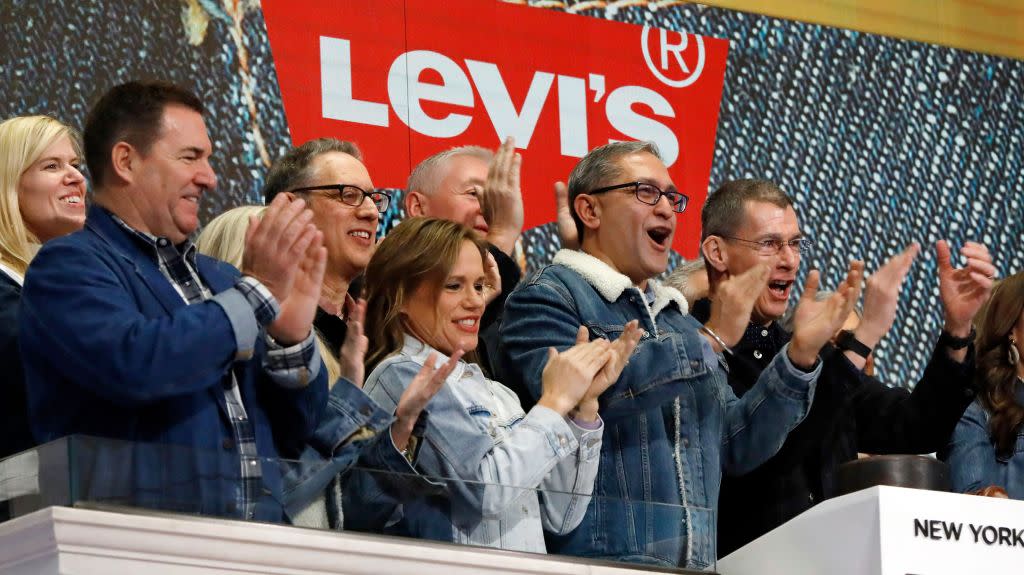Three things to consider as Levi Strauss returns to the public markets

In the world of brands, Levi’s is about as good as you can get. It enjoys a great origin story, global cachet, and a coolness that is enduring rather than ephemeral. The company’s reputation has been built over decades of investment, and under the current CEO, Chip Bergh, it has doubled down on innovation cemented in social and environmental values that will keep me a loyal consumer (although the company’s products are of a quality that I don’t have to replace them that often).
What lies ahead for the fashion icon as a public company in an age of turmoil? Following its March 21 listing on the New York Stock Exchange, I will be watching the company’s next act with three ideas percolating in the background.
1. Levi Strauss has earned its reputation and the Haas family, which stood by the brand through thick and thin for over a century, has earned its payout
In the 1980s, with the US garment industry flagging in the face of cheap labor in Asia and Mexico, the company was slow to move offshore. Levi Strauss built, and sustained, factories that became the heartbeat of towns in in the US Southeast as the region strained to keep pace with changes in a global marketplace. Levi’s resisted globalizing trends—and it paid the price.
Eventually, the company shut down its US manufacturing base, but with an unusual level of attention paid to the workers left behind. The signature values that guided these decisions have stood the test of time at the company. Today, Levi’s sets the bar for manufacturing standards in countries with little to no protection for human rights and labor conditions.
Haas family members, descendants of Levi Strauss himself, will remain the largest shareholders through a dual-class share arrangement that protects their control. The family stood by the brand through difficult times and demonstrated the kind of interest in worker well-being that could be a model for a new generation of innovators in the fashion industry.
2. The world is catching up with Levi Strauss’ values
Maybe Levi’s was one of the last big clothing brands to move offshore, but it was the very first to seize on a trend that now defines connections between brand, consumer awareness, and business voice. Way before Nike embraced Colin Kaepernick and signaled its position on his controversial treatment by the NFL, Levi’s linked its brand to the HIV crisis, demonstrating both courage and an understanding of brand “edge” that keeps young consumers returning to a 166-year-old enterprise. The current CEO has spoken out about gun control among other issues, so the tradition continues.
Behind the brand lies the real thing. As a private company, and with adherence to quality and a set of values that stand the test of time, Levi Strauss has been willing to experiment while setting a high bar on business decisions in a market swamped by the excitement and problems of “fast fashion.” Levi’s focuses on every step in the value chain to assure the highest social and environmental standards, from the growing of cotton to product design, and from the factory floor to the shaping of consumer habits, to radically reduce chemicals and water consumption and apply the highest standards anywhere for labor and human rights.
3. The company can attract the talent it needs to stay on the cutting edge of innovation
Bergh and his team get the formula that will keep the company on the cutting edge of innovation: Values stated must connect firmly with values employed. It’s not the cheapest way to operate, but the rewards are clear: When you define and design your product with the health of workers and the planet in mind, you will continue to access the best talent.
At the Aspen Institute, we have enjoyed working with the innovators and changemakers who keep the Levi’s brand fresh and accountable; five of the company’s enterprise-level leaders have engaged in our First Mover Fellowship and Leaders Forum to build the skills for systemic change in the company and industry. The commitment to innovation and transparency is evident in the bold moves identified by these individuals and then supported by the company through real investment. This is the kind of company millennials dream about joining—one where your aspirations connect to your paycheck.
Nevertheless, Levi Strauss has been at this rodeo before (it was a public company from 1971 to 1985), and I, personally, am sad to see Levi talent focus now on the demands of a stock market that continues to ask companies to externalize costs, discount the future, and misprice environmental risk. Given its track record—and ownership structure—I suspect, however, that Levi Strauss can stay on the frontlines of change.
Now it’s up to us consumers to stay the course and insist on the kind of leadership we so desperately need from the private sector at Levi’s and beyond. What we know from the success of the Levi IPO (ticker: LEVI) on day one is that the growing number of equity investors aligning their money and their values have also weighed in and joined this campaign.
Author Judith Samuelson is founder and executive director of the Aspen Institute Business and Society Program. Find her on Twitter at @JudySamuelson or on email at JSamuelson@AspenInst.org.
Sign up for the Quartz Daily Brief, our free daily newsletter with the world’s most important and interesting news.
More stories from Quartz:

